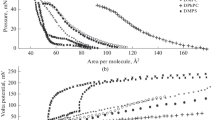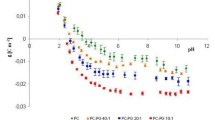Summary
It is shown that the Gouy-Chapman double layer analysis adequately describes the variation of the surface potential of monolayers of acidic natural lipids over a wide range of surface charge density and salt concentration. It is also shown that the potential which initially appears when an electrolyte gradient is rapidly imposed across a bilayer membrane is due to a difference in the double layer potentials on the two sides of the membrane. This conclusion follows from the fact that the observed bilayer potentials arise much more rapidly than can be accounted for by charge migration across the membrane and from the observation that the bilayer membrane concentration potentials, when measured immediately after establishment of a gradient, are equal to the surface potential change observed when the subphase concentration of a monolayer of the same lipid is changed by an amount equal to the gradient across the bilayer. The bilayer potential and monolayer potential changes, so measured, agree in a number of different electrolyte solutions over a wide range of electrolyte concentrations and surface charge densities. Because of this agreement and the applicability of the Gouy theory to monolayers, initial bilayer potentials may be calculated if the composition of the mixture used to form the membrane is known, provided that the pK's and areas of such components are available. In the absence of this information, membrane potentials may be calculated from electrophoretic data on the membrane lipid mixture; the conditions under which the latter approach is possible have been determined. The experimental results indicate that the composition of monolyers and bilayers spread from the same lipid mixture in decane are very similar, that the composition of the two types of film closely resembles the composition of the solution used to generate them, and that bilayer membranes are close-packed. The evidence further indicates that if any hydrocarbon solvent remains in these bilayers, it must be so situated that it contributes little, if anything, to the surface area. The steady state potential in the bilayer membrane system is frequently not identical with the initial potential which supports the hypothesis that in many cases only a fraction of the electrical conductance of unmodified membranes is caused by the ions which constitute the bulk electrolyte. An expression for the relationship between diffusion and double layer potentials has been derived which shows that, in the absence of any intrinsic selectivity of the hydrocarbon region of the membrane for hydrogen, hydroxyl, or impurity, the two potentials should be identical.
Similar content being viewed by others
References
Andreoli, T. E., Bangham, J. A., Tosteson, D. C. 1967. The formation and properties of thin lipid membrane from HK & LK sheep red cell lipids.J. Gen. Physiol. 50:1729.
Andreoli, T. E., Tieffenberg, M., Tosteson, D. C. 1967. The effects of valinomycin on the ionic permeability of thin lipid membranes.J. Gen. Physiol. 50:2527.
Bangham, A. D., Flemans, R., Heard, D. H., Seaman, G. V. F. 1958. An apparatus for the microelectrophoresis of small particles.Nature 182:642.
Bernard, L. de. 1958. Associations moléculaires entre les lipids. II. Lécithine et cholestérol.Bull. Soc. Chim. Biol. 40:161.
Cook, G. M. W., Redwood, W. R., Taylor, A. R., Haydon, D. A. 1968. The molecular composition of black hydrocarbon films in aqueous solutions.Kolloid-Z. 227:28.
Davies, J. T., Haydon, D. A., Rideal, E. K. 1957. Surface behaviour ofBacterium coli I. The nature of the surface.Proc. Roy. Soc. (London) B145:375.
Davies, J. T., Rideal, E. K. 1963. Interfacial Phenomena. Chap. 3. Academic Press Inc., New York.
Davson, H., Danielli, J. F. 1943. The Permeability of Natural Membranes. Cambridge University Press, Cambridge, England.
Dennis, V. W., Stead, N. W., Andreoli, T. E. 1970. Molecular aspects of polyene- and sterol-dependent pore formation in thin lipid membranes.J. Gen. Physiol. 55:375.
Eisenman, G., McLaughlin, S. G. A., Szabo, G. 1970. The use of molecular carriers of cations and anions as probes for assessing the functional significance of the charge of the polar head groups of phospholipid bilayer membranes.IUPAC Symp. “Physical Chemical Basis of Ion Transport through Biological Membranes” (Riga, U.S.S.R.).
Folch, J., Lees, M., Sloane-Stanley, G. H. 1957. A simple method for the isolation and purification of total lipids from animal tissues.J. Biol. Chem. 226:497.
Haydon, D.A. 1964. The electrical double layer and electrokinetic phenomena.In: Recent Progress in Surface Science. J. F. Danielli, K. G. A. Pankhurst, and A. C. Riddiford, editors. p. 94. Academic Press Inc., New York.
Haydon, D. A., 1969. Some recent developments in the study of bimolecular lipid films.In: The Molecular Basis of Membrane Function. D. C. Tosteson, editor. p. 111. Prentice-Hall, Inc., Englewood Cliffs, N. J.
Henn, F. A., Thompson, T. E. 1968. Properties of lipid bilayer membranes separating two aqueous phases: Composition studies.J. Mol. Biol. 31:227.
Henn, F.A., Thompson, T. E. 1969. Synthetic lipid bilayer membranes.Annu. Rev. Biochem. 38:693.
Hopfer, U., Lehninger, A. L., Lennarz, W. J. 1970. The effect of the polar moiety of lipids on the ion permeability of bilayer membranes.J. Membrane Biol. 2:41.
Lev, A. A., Buzinsky, E. P. 1967. Cation specificity of model bimolecular phospholipid membranes with incorporated valinomycin.Cytology 9:1.
Miyamoto, V., Thompson, T. E. 1967. Some electrical properties of lipid membranes.J. Colloid Interface Sci. 25:16.
Mueller, P., Rudin, D. O., Tien, T., Wescott, W. C. 1962. Reconstitution of excitable cell membrane structurein vitro.Circulation 26:1167.
Papahadjopoulos, D., Miller, N. G. A. 1967. Phospholipid model membranes I. Structural characteristics of hydrated liquid crystals.Biochim. Biophys. Acta 135:624.
Rathbone, L., Maroney, P. M. 1963. Preparation of phosphatidylserine.Nature 200:887.
Robertson, J. D. 1959. The ultrastructure of cell membranes and their derivatives.Biochem. Soc. Symp. 16:3.
Scatchard, G. 1955. Transport of ions across charged membranes.In: Electrochemistry in Biology and Medicine. T. Sedlovsky, editor. p. 18. John Wiley & Sons, Inc., New York.
Teorell, T. 1953. Transport properties and electrical phenomena in ionic membranes.Prog. Biophys. Mol. Biol. 3:305.
Author information
Authors and Affiliations
Rights and permissions
About this article
Cite this article
MacDonald, R.C., Bangham, A.D. Comparison of double layer potentials in lipid monolayers and lipid bilayer membranes. J. Membrain Biol. 7, 29–53 (1972). https://doi.org/10.1007/BF01867908
Received:
Issue Date:
DOI: https://doi.org/10.1007/BF01867908




